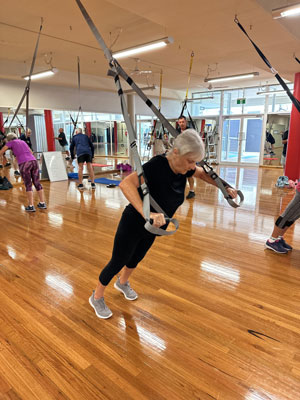
Age is just a number when it comes to prioritising our health and wellbeing. As we grow older, it becomes increasingly important to maintain our strength, flexibility and balance. That’s where TRX suspension training steps in, offering a versatile and effective workout option for athletes, rehab and the elderly. In this blog post, we will explore the numerous benefits of TRX suspension training specifically tailored to the needs of mature adults. Get ready to discover a training method that will revolutionise your fitness routine and help you age gracefully!
So what is suspension training?
Whether it is TRX, Crank-it or another brand of straps, the fundamentals are the same, suspension training provides a workout system that leverages gravity and your bodyweight to perform an amazing variety of exercises. As well as this huge variety of choice, it also allows you to be in control of how much you want to challenge yourself on each exercise because you can simply adjust your body position to add or decrease resistance.
Suspension training takes the simple (like a chest press or triceps extension) to become a core-stabilization exercise using your own body weight from different angles to engage more muscle groups at the same time.
'TRX trains for reactive stability,' says Chris Frankel, head of human performance at TRX.
'If your core isn’t tight, you’ll lose balance on the straps. Bracing your core before you move becomes second nature. You’re relying on your own ability to marry your center of gravity with your base of support.'
What are the benefits of TRX suspension training?
If you are just starting off or getting back into the gym, been injured or of an age where you are feeling like your range of movement is becoming limited or maybe you are a seasoned regular who just needs a boost in challenge and motivation for your workout, the suspension training can offer the following.
Enhances strength and stability
TRX suspension training engages multiple muscle groups simultaneously, promoting functional strength and stability. The adjustable straps allow you to modify the intensity of the exercises, making it suitable for all fitness levels. By improving strength and stability, TRX helps older adults to maintain proper posture, prevent falls and enhance overall physical performance.
Improves flexibility and joint mobility
Flexibility is crucial for maintaining a full range of motion and reducing the risk of injuries. TRX exercises incorporate stretching movements that target various muscle groups, helping to improve flexibility and joint mobility.
Low-impact and joint-friendly
One of the standout advantages of TRX suspension training is its low-impact nature. The adjustable straps provide a supportive environment, reducing stress on joints while still delivering an effective workout. This makes it ideal for older individuals who may have joint issues or arthritis, allowing them to exercise comfortably and safely.
Boosts core strength and balance
A strong core is the foundation for overall stability and balance. TRX exercises heavily engage the core muscles as they constantly work to maintain proper form and stability during movements. By incorporating TRX into your fitness routine, you can effectively strengthen your core, improve balance and reduce the risk of falls, which becomes more crucial as we age.
Customisable and adaptive
TRX suspension training is incredibly adaptable, making it suitable for individuals of all fitness levels. The adjustable straps allow for easy modification of exercises, ensuring that workouts can be customised to meet individual needs and goals. Whether you’re a beginner or an experienced athlete, TRX can be tailored to challenge you at your own pace.
What are some of the mistakes commonly seen using TRX suspension training?
Suspension training exercises are amazingly effective, but like everything else in the gym, there is the right way and then there are those wrong methods which either cause injures or niggles. Here are some the mistakes we suggest you should avoid when attempting any suspension training exercises.
When facing the straps, avoid:
- arching—when attempting exercises like bicep curls or Y shoulders and starting to fatigue, it is common to 'lead with your stomach' and arch your back. Avoid this by tightening your core, squeezing your glutes. If necessary, you can also adjust your body angle to make the movement easier and finish the set
- slack straps—if you find the straps become slack during a moment, it probably means you’re being slack too! Always keep tension through the straps throughout every exercise movement. The best method to avoid this is slow down and if this doesn’t work, lean more into the horizontal position
- incorrect start position—always find your end point in the movement. From here, you can adjust to the correct foot position and stance to correctly perform the exercise at your level. Too often, you see people fall back with straps slack and it can result in injury
- hunching—always remember to keep your shoulders down and allow scapula movement during any push or pull exercises. Again, as you fatigue, it gets harder to hold your torso in correct posture. If necessary, you can also adjust your body angle to make the movement easier and finish the set.
When laying prone with feet in straps, avoid:
- hip sag—this is my biggest no no when training. If you are focusing on your core, it’s imperative that you have good core and plank technique (even before attempting this). As you fatigue, it gets harder to hold your torso in correct posture. If you find your hips sagging or back arching during a movement, ensure your core is turned on and if necessary, regress the movement to an easier version to be able to finish with proper spine position. Failing to do this can result in injury.
Conclusion
From building strength and stability to improving flexibility and balance, TRX provides a safe and effective workout option that can be customised to suit individual needs. Remember, technique is king!
We have 2 TRX Classes a week with Coach Nic. Check out our
timetable for class times.